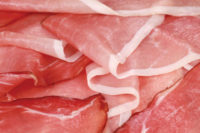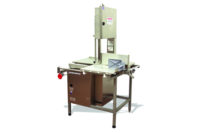"The harder something is to dissemble and clean, the lesser the probability that it will be done correctly,” says Richard F. Stier, consulting food scientist at Stratecon International Consultants, based in Sonoma, Calif.
Such is the problem with food processing machines. Slicers in particular need to be dissembled for thorough cleaning to prevent pathogens from taking hold in cracks and crevices. New equipment features are making this process easier and improving food safety — and employee safety as well.
“In short, slicers should be made of compatible materials [all stainless], be easy to dissemble for cleaning [snaps, clips and as few parts as possible] and safe to operate,” says Stier.
In general, all equipment must be able to be completely disassembled for proper sanitation.
“One of the bigger concerns I see in the industry is that the cutting blades on equipment do not get completely pulled apart and therefore much food gets trapped within joints or gaskets — and therefore not cleaned properly, leaving old product to contaminate the new,” says Warren Gilbert, food safety specialist at FSS Corp., based in Elkhorn, Wis.
Equipment needs to be disassembled quickly and efficiently to ensure cleaning is completed properly without affecting the overall efficiency of the facility, he says.
“Quick-connect clamps and accessibility helps with the cleaning process,” Gilbert says.
According to Gerald Lessard, vice president and chief operating officer of West Liberty Foods, in West Liberty, Iowa, the new generation of slicers has an “open architecture,” which allows for a more thorough cleaning of the slicer. “The hygienic design of this feature enhances food safety by minimizing the harborage areas of the slicer,” he says.
In addition, plants are isolating their slicing areas to prevent cross-contamination.
“Our slicing area is an isolated area of the plant,” says Tom Wisvari of Cooper Farms Food Processing Division, in St. Henry, Ohio. “The team members who work in this area have their own entrance, parking lot, break rooms and restrooms.”
Cooper Farms also maintains separation of each slicing line for food safety.
“Each line is enclosed within its own cell and has its own air filtration unit,” Wisvari says. “All product goes through an ozone tunnel after being stripped from its casing to maintain food safety as it transitions into the room.”
The company’s clean-room slicing and high-pressure pasteurization area also have its own sanitation cabinet and crew, separate from the rest of the Cooked Meats Plant, he says.
“The majority of our products are run through high-pressure pasteurization, or HPP, which allows us to provide a clean label, another level of food safety and a longer shelf life without additives,” Wisvari says.
Automating the loading process
To prevent worker injuries, slicers are also being automatically loaded.
“The logs are automatically loaded into the slicers, eliminating the need for a team member to lift the product during loading,” says Wisvari. Cooper Farms has developed an HPP tube revolver, which is air-actuated to allow for more comfortable tube loading.
“There are 16 tubes which we load with product to go through the HPP process,” Wisvari says. “The revolver allows each tube to be loaded at a comfortable position; there is no longer any bending over or lifting. This was an invention developed by one of our team members and is now patented.”
Mechanical assistance in the form of log lifts or conveyors can provide the heavy lifting of the slice logs.
“Automatic log loading of the slicer reduces fatigue and potential injury,” Lessard says. “The use of pick-and-place robots to move finished portions from the slicer to the packaging machine have a wider acceptance today and are being used to increase throughput.”
Auto loading of the finished portions to the package has been available for some time, he says, and reduces the potential for ergonomic injuries.
Optimizing equipment technology
In addition to a robust in-house preventive maintenance schedule, West Liberty Foods utilizes periodic original equipment manufacturer (OEM) reviews of critical equipment, including slicers, on a regular basis.
“This review audits our equipment and processes to ensure that we are optimizing the equipment,” Lessard says. “Additionally, we receive a scorecard on how well we are taking care of the equipment to prolong the longevity of the asset.”
Blade technology has continued to advance and includes a wide variety of honing angles, coatings and profiles to provide optimal slicing results in a wide array of products.
“‘Smart’ blade honers recognize the blade that needs to be honed through RFID [radio-frequency identification] chips imbedded in the blade,” Lessard says. “The honer then sharpens the blade to the preprogrammed specifications for the blade, minimizing human error.”
Control of the slicing log is critical to repeatable slicing results. “Again, technology has improved with down holders, side pushers and fitted orifices to assist with maintaining control of the slice log during the slice process,” says Lessard.
Plant personnel’s input goes a long way in creating new slicing equipment.
“Our slicer supplier has continually updated the equipment to enhance food safety and lower the cost of ownership,” Lessard says. “In addition, they actively seek out input from us and other customers as to design changes that will improve the equipment. Many of our team members recommended changes that have been incorporated into the next generation of slicers. NP






Report Abusive Comment